William Shakespeare: The Cloud Capp'd Towers
Very little is known about Shakespeare’s day-to-day movements, so we have selected some of the more interesting locations of his history plays for consideration.
The first is Pontefract Castle (1), which is the location in Richard II where the King is imprisoned, and later dies. Pontefract, or Pomfret as it was often called was one of the most imposing castles of the mediaeval period. The first fortress on this site was built by Ilbert de Lacy, one of the knights of William the Conqueror, who was granted extensive estates in West Yorkshire. The original wooden structure was replaced with stone in the 12th century and was repeatedly extended over the centuries. The de Lacy family eventually received the earldom of Lincoln, which passed through Alice de Lacy to her husband Thomas of Lancaster, grandson of Henry III. The castle was thus part of the Duchy of Lancaster, and continues to be part of that Duchy which is Her Majesty the Queen’s personal estate.
At one time the castle had 10 towers and very extensive dungeons. In 1399 Richard II disappeared into one of these dungeons where he probably starved to death, either through deliberate neglect or possibly by refusing food himself. During the Wars of the Roses it was also the location for the execution of Sir Richard Grey, son of Queen Elizabeth Woodville, his uncle, Anthony, Earl Rivers and Sir Thomas Vaughan, Edward V’s Chamberlain, following their capture by Richard, Duke of Gloucester, at Stony Stratford.
The castle was still used during the Tudor period, and was visited by Henry VIII and Queen Katheryn Howard on their trip to York in 1541. It was the last castle to fall to the Parliamentarians during the Civil War, after which it was ‘ slighted’. Pontefract is located some 18 miles south-east of Leeds, a few miles off the A1. The extensive ruins are open to the public.
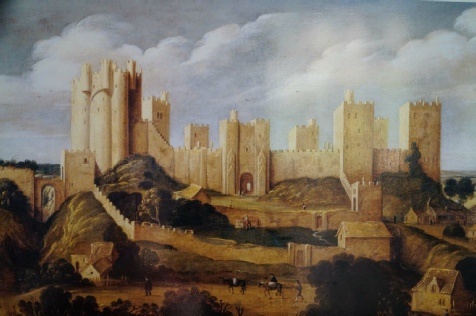
The next location is Windsor Castle (2) one of the most important castles in royal history, from the Norman Conquest to the present day. It is the location of the final scene of Richard II, in which Henry Bolingbroke both laments and rejoices in the death of Richard:
‘though I did wish him dead,
I hate the murderer, love him murdered’
He promises to go on pilgrimage to expiate the sin.
The Castle, which now extends to some 13 acres, was first constructed during the reign of William the Conqueror, on a hill on the north side of the River Thames. The Round Tower which dominates the complex was constructed in the 12 th century and it was in this tower that Henry III created a palace. Windsor was a favoured home of Edward III, who, loving tales of chivalry, instituted the Order of the Garter, whose Chapel of St George is located within the Castle precincts.
Dating from the late 15th and early 16th centuries, the chapel is the burial place of (among others): King Edward IV and Elizabeth Woodville; Henry VIII’s brother-in-law, Charles Brandon, Duke of Suffolk; Henry VIII and his third wife, Jane Seymour; Charles I and an infant child of Queen Anne. The latter four are all in a single vault. Windsor is also the resting place of Princess Charlotte of Wales, the only child of George IV, who was heiress presumptive to the throne, until her death in childbed at the age of 21. In more modern times King George V, Queen Elizabeth, the late Queen Mother, and Princess Margaret were interred here.
Many of the later buildings are 18th and 19th century structures and extensive rebuilding took place after the terrible fire of 1992. Windsor Castle remains the largest occupied castle in the world, located in the town of the same name, around 25 miles to the west of London off the M4. It is the Queen’s favoured private weekend residence, as well as being a working Palace. It has been announced that this is the location where Her Majesty will spend her 90th birthday, on 21st April 2016.
Moving on from Richard II to the tripartite Henry VI, we return to London. A number of scenes take place in the Tower of London (3), which, contrary to what Shakespeare believed, was not constructed by Julius Caesar, but by William the Conqueror. It was a frequently used royal palace up until the reign of Henry VIII. Henry VII and Elizabeth of York seem to have been the last King and Queen to use the Tower consistently as a residence. It is unlikely to have had happy memories for Henry VIII as it was to the Tower in 1497 that he and his mother and siblings retreated for safety during the march on London of the Cornish rebels. It was also the location where Elizabeth of York died in childbirth. Nevertheless the Tudor monarchs did continue to sleep at the Tower immediately prior to their coronations.
The Tower of London is the setting for Act II sc. v in Henry VI Part 1 , in which Edmund Mortimer, whose claim to the throne had been bypassed by the usurpation of Henry IV, bequeaths his rights to his nephew, Richard, Duke of York. Shakespeare takes the opportunity to rehearse the Yorkist claim to the throne. It is also at the Tower, in Part 3 of the trilogy that Henry VI is seen restored to his throne and where Henry, Earl of Richmond (later Henry VII) is presented to him. In a moment of prophecy Henry VI lays his hand on the boy’s head and proclaims
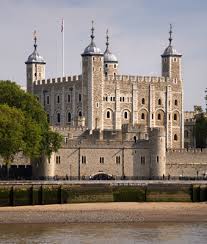
‘This pretty lad will prove our countries bliss,
his looks are full of peaceful Majesty
his head by nature formed to wear a crown
his hand to wheel the sceptre, and himself
like in time to grace a regal throne.”
Henry VI Part 3 IV vi
This speech was no doubt music to the Tudor audience’s ears.
The penultimate scene of Henry VI Part 3 also takes place in the Tower where the King is slaughtered by the Duke of Gloucester. This death, whether or not it was at the hands of Gloucester, was probably ordered by Edward IV, but it would have been impolitic for Edward IV, Elizabeth I’s great-grandfather, who had always received a very positive treatment by Tudor historians to be accused of a secret murder. The probable location of Henry’s death is still visible today as the Tower is open to the public. It is definitely worth braving the queues to visit.
Another London landmark, of which few people are aware, is the Temple Gardens (4), located on the north bank of the Thames, close to the tube station of the same name. The Gardens are owned by the Honourable Society of the Inner Temple – one of the Inns of Court where lawyers were trained both during the Middle Ages and today. The Temple Garden is the location in Henry VI Part I Act IV Sc. ii where Shakespeare placed the quarrel between York and Somerset that led to the plucking of the red and white roses by their supporters.
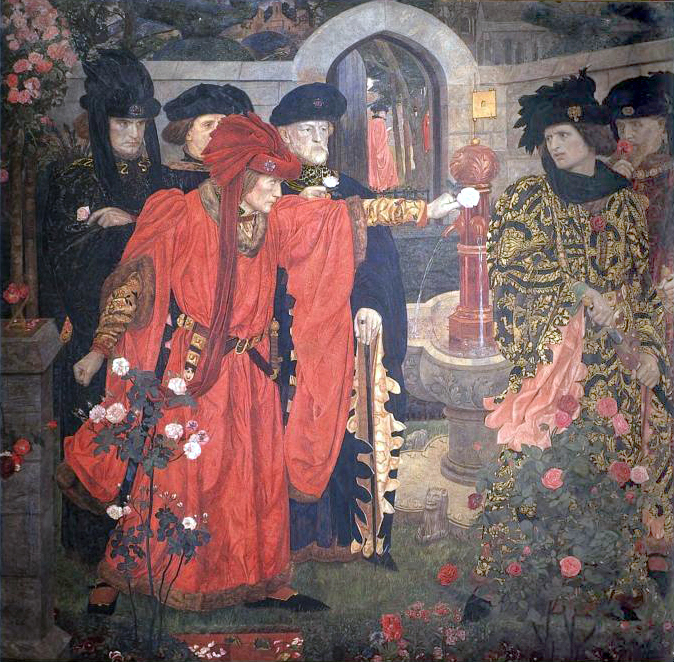
The scene was somewhat anachronistic in that the Lancastrians did not commonly use a red rose – they generally sported the Silver Swan or the crowned Antelope. It was Henry VII who popularised its use as a symbol of Lancaster. Nevertheless the scene did give rise to one of the most familiar images of the Wars of the Roses, as shown here. The Temple Gardens today can be visited and, although the layout is very different from that of the mid-15 th century, they are certainly worth seeing, a haven of peace in the busy city.
The rest of Henry VI Part 1 and the beginning of Part 2 show the country descending into civil war. In Act III Sc i, the court is found at the Abbey of Bury St Edmunds (6) in Suffolk. They are debating the merits of Humphrey, Duke of Gloucester, whom the Queen, and the Dukes of York and Suffolk are accusing of treachery, whilst the King defends him. His detractors conspire to murder him. In reality, the Duke did die in Bury St Edmunds in 1447 amidst allegations of foul play – although he lingered for several days in what sounds like the after-effects of a stroke.
The Abbey of Bury St Edmunds was another of the great Benedictine monasteries of the Middle Ages. Founded by Edward the Confessor in 1020, it housed the bones of the Anglo-Saxon king, Edmund the Martyr, killed by the Vikings, allegedly for refusing to renounce his Christian faith after being defeated in battle in 869 AD. Although East Anglia is nowadays a relatively quiet corner of the United Kingdom, in the 15 th century it was the commercial powerhouse of England. This is reflected in the wonderful churches of the area and particularly in the Abbey itself, whose extensive remains are in the care of English Heritage.
The Lancastrian court spent significant portions of its time in the Midlands, particularly around Coventry. This area was the heart of Queen Marguerite of Anjou’s own lands, and enabled her to raise troops and money. Centrally located in England, it enabled the Lancastrians to try to block movements between the Duke of York, based largely at Ludlow on the Welsh Border, and his Neville allies, the earls of Salisbury and Warwick whose lands were centred in the North.
The transfer of the court to Coventry has been cited by Chris Skidmore in his book ‘Bosworth’ as one of the reasons for Lancastrians unpopularity in London which, deprived of the court, felt itself slighted as well as impoverished. The castle at Kenilworth (7), not far away from the city, is the location of Henry VI Part 3 Act IV Scene ix. The court is waiting for news of Jack Cade’s rebellion. In real life it was also the location where, after the Battle of Edgecote, Warwick, now fighting for the Lancastrians, executed Sir William Herbert, Earl of Pembroke, Elizabeth Woodville’s father, Earl Rivers and brother, John. Kenilworth was later in the ownership of Robert Dudley, Earl of Leicester, and was the location of one of the most famous pageants of Elizabeth I’s reign.
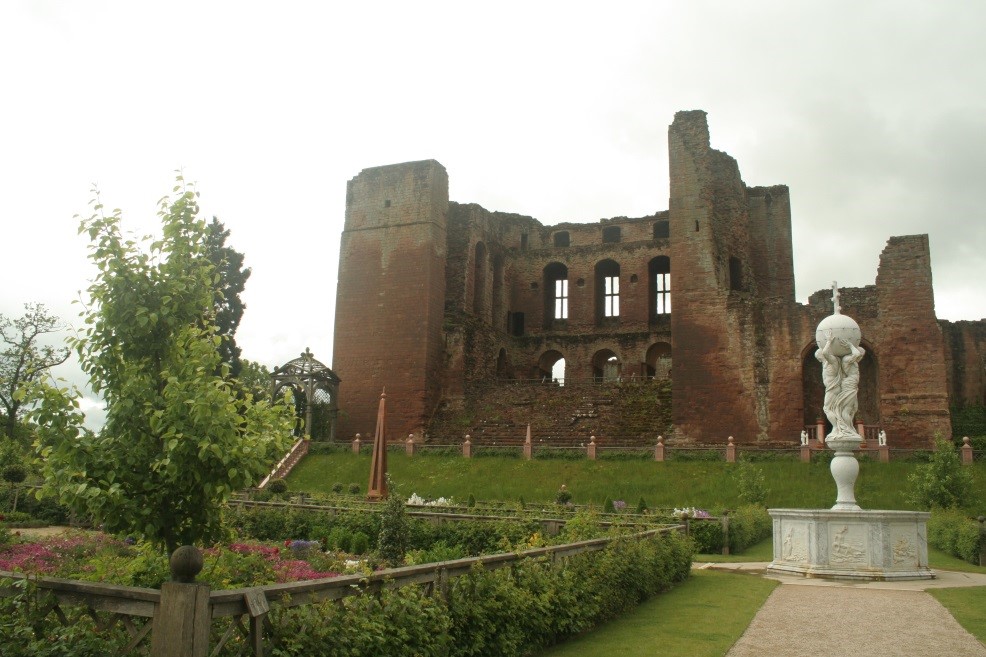
Events spiral out of control at Henry VI’s court, and by Act V Sc. 2 the contending parties find themselves at St Albans (5) where the first battle of the Wars of the Roses took place on 22nd May 1455.
St Albans was originally an Iron Age settlement which became the Roman town of Verulamium about a day’s march north of London on the Roman road, now disguised as the A1081. The town is named for an early Romano-British Christian martyr. The original foundation of the Abbey was in 793 AD, replaced in 1077. The Abbey was dissolved in 1539 and the monastic church became a parish church until 1877, when it was elevated to the status of a cathedral, making St Albans a city. The layout of the streets of the modern town is still identifiably that of the mid-15 th century with the crossroads centred on the marketplace where regular markets have taken place for some 1200 years.
Moving forward in time to Richard III, we are now back in London. In Act III Sc. VII, placed in Baynard’s Castle (8), we see Gloucester receiving news from the Duke of Buckingham about how the citizens of London had taken his claim to be King. The castle (the second of that name) which is now completely buried under the dual carriageway and brutalist buildings of Upper Thames Street, was a major London palace. Edward IV gave it to his mother Cicely Neville, Duchess of York. The castle was later granted to Katharine of Aragon, and then Anne of Cleves. Transferred to the earls of Pembroke, for a short time it was the home of Lady Katherine Grey. The castle was burnt to the ground during the Great Fire of 1666.
In Richard III, the Duke of Gloucester becomes King, aided by the Duke of Buckingham, so the rebellion of Buckingham comes as a terrible shock to him. The Duke is captured and brought to Salisbury (9) for execution. Salisbury, in Wiltshire, is close to the ancient monument of Stonehenge and the Iron Age fortress of Old Sarum. It has an impressive cathedral (begun in 1220), with the tallest spire in Britain, which houses a copy of Magna Carta and the remains of the chantry chapels for the Beauchamps and Hungerfords, suppressed in 1548.
In the final act of Richard III we see the two camps – Henry’s near Tamworth (10) in Staffordshire and Richard’s near Bosworth (11) in Leicestershire. In Shakespeare’s time the battlefield location was still known to locals but it was soon to be lost. In a fascinating new account of the archaeological digs that have taken place there in the last few years, ‘Bosworth 1485: A Battlefield Rediscovered’, Glenn Foard and Anne Curry give a detailed account of the location and layout on the battlefield.
With the triumph of Richmond at the end of Richard III, Shakespeare’s great cycle of the Wars of the Roses is complete. His later work, Henry VIII was written in conjunction with John Fletcher.
Most of the action in Henry VIII takes place in and around the King’s palaces in London. Westminster Hall (12) is referred to as the location where the Duke of Buckingham is tried for treason. We do not actually witness the trial, but it is seen to be as a result of Wolsey’s malice and ambition. The extant records suggest that even if he had no absolutely treasonable intentions, Buckingham felt himself to be very little inferior to the King in rank, and certainly lacking the deference to Henry VIII that the King expected.
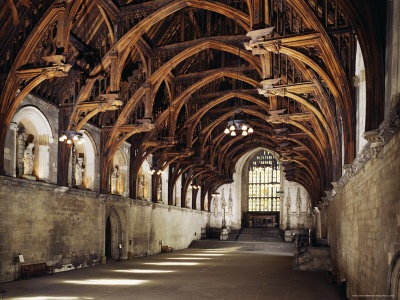
Westminster Hall, originally built by William II in 1097 and given its structurally astonishing hammer-beam roof commissioned by Richard II in 1393, is the only remaining part of the great mediaeval palace complex that burnt down in 1834. Westminster Hall was where the monarch dined in state and where the law courts were conducted until the 1820s. The Hall, at one end of the current Houses of Parliament, is still accessible by the public, although booking a guided tour is now required.
Another important location in the play is Wolsey’s York Place (13). This was the London home of the Archbishops of York which was significantly enhanced and beautified (a word coined by Shakespeare) by Wolsey. In Act I sc. ii it is where Henry first meets Anne Boleyn. Struck by her charms he exclaims:
'The fairest hand I ever touch'd! O beauty,
Till now I never knew thee!'
Henry VIII I ii
Following Wolsey’s fall, York Place became the Palace of Whitehall. None of the mediaeval Tudor palace remains, the only remnant of the palace from earlier times is the Banqueting House. Built for James VI & I, it was the scene of the court masques so beloved of his queen, Anne of Denmark. Their son, Charles I, commissioned the fabulous Rubens ceiling, and it was from one of the Banqueting House windows that Charles I emerged onto especially built scaffolding to face execution. The Banqueting House is in the care of Historic Royal Palaces, and is open to the public.
Central to the drama of Henry VIII is the scene at Blackfriars (14). Blackfriars was a Dominican monastery and the location of the Legatine Court presided over by Cardinal Wolsey and Cardinal Campeggio – named Campeius in the play – in 1529. This is the scene in which Katharine makes the famous speech wherein she lays in front of the King the history of their marriage.
Shakespeare lived near Blackfriars for a period and in 1608, his acting company, the King’s Men, erected a new theatre there. Three years before his death, Shakespeare purchased part of the old monastery – possibly to live in himself, or perhaps for an investment.
In the play, as in life, Queen Katharine’s appeal to her husband falls on deaf ears and she is banished to Kimbolton Castle (15) in Bedfordshire. Kimbolton was extensively renovated in the 17 th and 18th centuries and bears little resemblance to the castle that Katharine would have known – although there are some traces of her chamber and chapel remaining. These are not generally open to the public, as the building is now a school.




